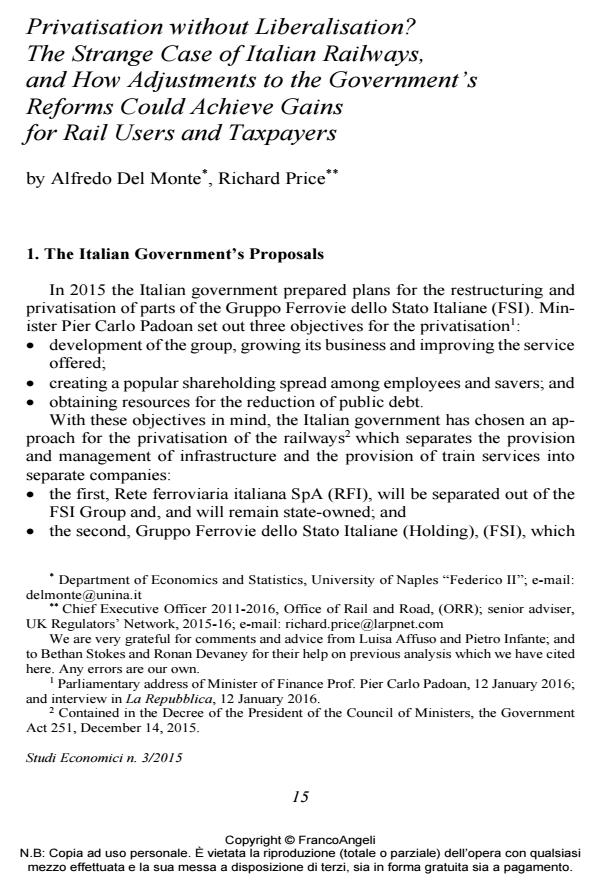Privatisation without Liberalisation? The Strange Case of Italian Railways, and How Adjustments to the Government’s Reforms Could Achieve Gains for Rail Users and Taxpayers
Titolo Rivista STUDI ECONOMICI
Autori/Curatori Alfredo Del Monte, Richard Price
Anno di pubblicazione 2016 Fascicolo 2015/117
Lingua Inglese Numero pagine 14 P. 15-28 Dimensione file 201 KB
DOI 10.3280/STE2015-117002
Il DOI è il codice a barre della proprietà intellettuale: per saperne di più
clicca qui
Qui sotto puoi vedere in anteprima la prima pagina di questo articolo.
Se questo articolo ti interessa, lo puoi acquistare (e scaricare in formato pdf) seguendo le facili indicazioni per acquistare il download credit. Acquista Download Credits per scaricare questo Articolo in formato PDF

FrancoAngeli è membro della Publishers International Linking Association, Inc (PILA)associazione indipendente e non profit per facilitare (attraverso i servizi tecnologici implementati da CrossRef.org) l’accesso degli studiosi ai contenuti digitali nelle pubblicazioni professionali e scientifiche
The Italian government is proceeding with the privatisation of the Ferrovie dello Stato Italiane (FSI Group), and is considering a merger with the government-owned highways company. A further proposal has been made to merge the FSI Group with Azienda Nazionale Autonoma delle Strade SpA (ANAS), the state-owned company which owns and manages large parts of the national road network. In this article both aspects will be examined. We argue that changes could be made to the privatisation and reform process, learning from the British experience, which would bring substantial benefits to Italian rail users and taxpayers.
Parole chiave:Railways, Privatization, Competition, Italy
Jel codes:L92, H54, L43
- Affuso L. and Newbery D.M.G. (2000), Investment, Reprocurement and Franchise Contract Length in the British Railway Industry, CEPR Discussion Paper 2619, Centre for Economic Policy Research, London.
- ANAS (2016), Budget Economico Annuale – Esercizio 2015.
- ANAS (2016), Budget Economico Pluriennale 2015-2017.
- Bogo F. (2016), Armani e la fusione Anas Ferrovie “Tre tappe per arrivare sul mercato”, Il Sole 24 Ore, 4.
- Competition and Markets Authority (2016), Competition in passenger rail services in Great Britain, March.
- Department for Transport (2016), Passenger Services Franchise Competition Guide, January, London.
- European Commission (2008), Road infrastructure cost and revenue in Europe Report, Bruxelles.
- European Commission (2013), Europeans’ satisfaction with rail services, Eurobarometer report 382a, Bruxelles.
- European Commission (2014) Rail Market Monitoring Study report, Bruxelles.
- Istituto Nazionale Di Statistica (ISTAT), Rilevazioni sul trasporto su strada e sul trasporto ferroviario, 2014. http://www.istat.it/it/archivio/178014
- Office of Rail and Road (2016), GB Rail industry 2014-15 Financial information, March, London.
- Padoan Pier Carlo (2016), Interview in La Repubblica, 12 January.
- Price R. (2015), Regolamentazione delle ferrovie. L’esperienza Britannica, Rivista T_CESIT, No 8.
- RSSB (2016), Annual Safety Performance Report 2014-15, London.
- Shaw N. (2016), The Shaw Report: The future shape and financing of Network Rail, March, London.
- The Economist (2013), Coming round the bend: How Britain developed a truly competitive rail freight market, 22 June.
- Transport Focus (2016), National Rail Passenger Survey, Autumn 2015, January, London.
Alfredo Del Monte, Richard Price, Privatisation without Liberalisation? The Strange Case of Italian Railways, and How Adjustments to the Government’s Reforms Could Achieve Gains for Rail Users and Taxpayers in "STUDI ECONOMICI " 117/2015, pp 15-28, DOI: 10.3280/STE2015-117002